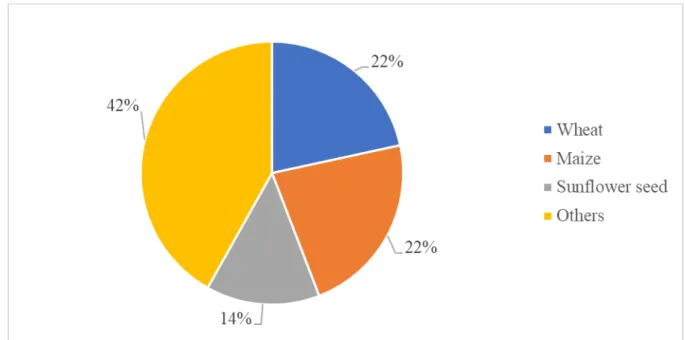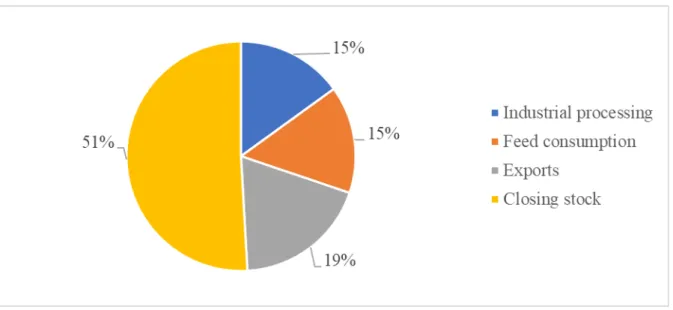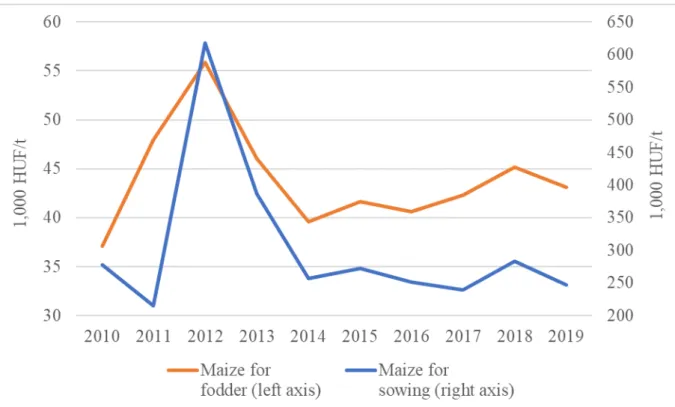THE SIGNIFICANCE OF THE HUNGARIAN MAIZE PRODUCTION IN RELATION TO THE COMMON AGRICULTURAL POLICY
TAMÁS MIZIK1,ZOLTÁN MÁTÉ RÁDAI1
Corvinus University of Budapest, 1093 Budapest, Fővám tér 8.
*Corresponding author: tamas.mizik@uni-corvinus.hu
ABSTRACT
Maize is one of the major crops of Hungary. This can be used in various ways, most notably for human consumption, feeding purpose, and ethanol production that is used as a fuel additive. The major indicator of its market competitiveness is the maize yield which varied over the years. This was mostly caused by the weather conditions. The use of more resistant maize varieties, as well as the proper amount of fertilizer (especially nitrogen and potassium as active ingredients), would help to stabilize yields. On the sales side, the price determines the efficiency of production. The Common Agricultural Policy plays a key role in this regard as direct payments contributed to the gross revenue of the crop producers by 57.2% on average in Hungary. The article aims to provide a detailed overview of these issues from 2010 to 2020. Based on our results, we formulated policy recommendations. Regarding maize trade, processing and, therefore, a higher share of value-added products would be essential (canned products, gluten, corn germ oil, gluten) on the export side. This would further increase Hungary’s agri-food trade surplus as well as create new jobs in this sector. However, the exceptional (roughly 47%) price increase in 2021 may not be motivating enough for the different market players in the supply chain.
Keywords: maize production, international trade, common agricultural policy
INTRODUCTION
Feeding the world is one of the greatest challenges of humanity. The population is expected to reach 10 billion by 2050 (FAO, 2017). Hungary has great production opportunities and maize is one of the two major agricultural crops. Therefore, it is important to analyze its main characteristics. Due to the land abundance and favorable weather conditions, production greatly surpasses consumption resulting in a significant trade surplus. However, the sector is vulnerable to extreme weather conditions, e.g.
droughts and heatwaves.
It should be highlighted that the different EU supports are extremely important in Hungarian agriculture. Direct payments of the Common Agricultural Policy (CAP) contributed to the gross revenue of the crop producers by 57.2% on average (KESZTHELYI – KIS CSATÁRI, 2020). This motivates farmers to produce crops like maize. However, this is a clear indicator of support dependency and suggests serious competitiveness problems of the cereals sector too.
Maize traditionally has been and is still an important product of the Hungarian agriculture.
The maize markets show a notable surplus and there is always a satisfactory demand for this product in the different markets. It should be noted that its unit value is low, therefore, it is not profitable to be transported to long distances without transforming maize into higher value-added products.
The aim of this paper is to give an overview of the Hungarian maize production, describe the characteristics of Hungarian maize use and summarize our results and provide concluding remarks.
Characteristics of the Hungarian maize production
Maize is one of the most important crops in Hungary and its role within cereals is also significant. It is further supported by its significant share in the utilized agricultural area (UAA), which is shown in Figure 1. Based on this, it can be said that wheat and maize production areas were almost the same in 2020, so by far, these two are the most significant arable crops. The share of sunflower is roughly half (14%) compared to the two above, while rapeseed and various fodder crops are included in the other category.
Figure 1. The major Hungarian crops by UAA, 2020 based on HCSO (2021a) and HCSO (2019) data
The important role of maize in terms of both supply and demand can be justified by several factors. On the supply side, it is worth highlighting, for example, that the Hungarian arable land is excellent for cultivation, the weather conditions are appropriate, the expertise and significant production experience of farmers are present. On the demand side, the most important aspect is the widespread and diverse use of maize, as in addition to the food industry use (isosugar, maize mush, canned maize, etc.), feed maize is an important raw material in livestock breeding, and the industrial use should also not be overlooked (ethanol and distiller’s grains with solubles as a co-product). As the production level significantly exceeds the domestic market demand, maize is also an important agricultural export product as well.
The two most important indicators of production are the area used for production and the average yield. The development of these two elements is illustrated in Figure 2 for the last 11 years (2010-2020).
Figure 2. Area used for maize production and average yield, 2010-2020 based on HCSO (2021a) data
Based on the figure above, a steady decline of the harvested area can be seen during the analyzed period, with the two extreme values being 939 thousand hectares (2018) and 1,243 thousand hectares (2013). The average value of the 11 years is 1,093 thousand hectares. It is worth highlighting that in 2017, 2018, and 2020 the production area fell below 1 million hectares. This is fundamentally determined by the characteristics of the production technology being used (mainly the crop rotation) in addition to the expected and actual market conditions. To put this value in a broader context, it shows that the maize production area occupies 21-29% of the total Hungarian arable land used for cereals production, which proportion is the same as that of wheat.
In terms of production, the average yield is increased significantly, by 33.23% over the last 11 years (HCSO, 2021a). One of the most important contributors to this value is the weather condition, but the unfavorable circumstances, such as droughts, resulted in a significant negative change. The figure clearly shows how the – typically substantial – upward trend is broken by the year 2012 when there was both drought and record warm
weather. The 4.00 t/ha at that time did not even account for half of the 2016 record harvest (8.63 t/ha). It is likely that the use of more efficient seeds or modern technologies (such as precision farming) makes it possible to surpass even the latter in the near future. PINKE ET AL. (2020) highlighted that groundwater level is less studied; however, it is an extremely important factor. According to their results, the decrease in the groundwater can cause as much as 0.65 t/ha maize yield loss. Fertilization, in line with soil conditions and the needs of maize, also plays an important role. HOFFMAN (2018) calculated that to achieve a result of 9–10 tons yield, 120–160 kg of nitrogen, 50–70 kg of phosphorus, and 70–120 kg of potassium per hectare should be applied for grain maize. According to the author, slightly more than this is needed to achieve a result of 50-60 tons of silage corn and 20-25 tons of sweet corn. VÁNYAINÉ SZÉLES ET AL. (2012) suggested the on-site measurement of the chlorophyll content of the leaves as an adequate indicator of the nitrogen need of maize.
However, management issues are as important as weather and crop yield variability for the proper forecast of maize yields (BUSSAY ET AL., 2015).
Characteristics of maize use
The use of corn is diverse, as it is suitable for food, feed, and industrial purposes. Figure 3 illustrates the most significant purposes.
Figure 3. Purposes of maize use, 2019 based on HCSO (2021b) data
Figure 3 shows that most of the 16.87 million tons of maize used in 2019 were stored (closing stock), followed by exports. Feed and industrial use accounted for 15-15%. As the loss was only 0.42% while the seed use was 0.17%, these items are not even included in the figure above. 2.67% of the total volume served human nutrition directly (HCSO, 2021b).
As corn is an important export commodity, it is also worth looking at the sector’s foreign trade performance. Table 1. shows the volume and value of exports and imports, and the overall trade balance, with the average price observed in each relation too.
Table 1. Cornerstones of maize trade, 2019
Volume (t) Value (million HUF) Average price (1,000 HUF/t)
Import 204,505 41,813 204.46
Export 3,173,863 247,433 77.96
Trade balance 2,969,358 205,620
Based on HCSO (2021b) data
Table 1 shows that maize exports are 2.97 million tons higher than imports. This difference means a trade surplus of more than 205 billion HUF. In terms of the average price, there is a significant difference between the two relations, so it is likely that the proportion of seeds in imports is significant, which is also supported by the clear substantial price difference shown in Figure 4.
Maize can be used in various ways, but the main differences can be observed in terms of feed and seed. Figure 4. shows the price evolution of them over the period considered.
Official data of the Hungarian Central Statistical Office is not yet available for 2020.
However, maize prices increased slightly from 2019 to 2020 followed by an enormous, 47% increment in 2021 (PÁSZTOR -ECSEDINÉ WANEK, 2021).
Figure 4. Price development of various maize types, 2010-2019 based on HCSO (2021c)
Figure 4. shows the significant price difference between the two varieties, the seeds are substantially more expensive than fodder maize, which is why it was necessary to use the secondary axis. The difference was the smallest in 2011 (4.48 times) and the highest in
2012 (11.07 times). The latter was due to the extremely bad weather of that year and thus to the decline in production volumes.
The supply of maize is mainly influenced by the steadily increasing average yields and weather conditions, as the production area typically fluctuates around 1 million hectares.
On the demand side, the impact of several factors is worth highlighting. As the use of animal feed is significant, the contraction of the domestic livestock sector is definitely unfavorable. However, this effect is largely offset by the increasing industrial use, especially ethanol production. Although, the use of high ethanol fuels (such as E85) has dropped drastically as a result of the increase in its excise duty, the mandatory blending rate is generating stable and significant demand for maize-based ethanol. This process was further strengthened by the fact that the mandatory bioethanol blending share increased to 6.1% (GOVERNMENT DECREE 186/2019 (VII. 26.)) from 1 January 2020. However, in connection with the production, it should not be forgotten that the main by-product of dry milling technology, which provides a higher ethanol yield, is distiller’s grain with solubles, which can be used mainly as feed (MIZIK ED., 2018). It is also worth to note that corn products, as opposed to wheat, can be consumed by people who are sensitive to gluten, for example.
Processing of maize provides many promising opportunities, including different final products. The price would be much higher due to the higher added value, which in the case of ethanol, for example, can be up to 75% higher than the export of maize in unprocessed form (SZÁZADVÉG, 2017). Moreover, the research of SZÁZADVÉG (2017) also revealed that even this relatively high value can be further increased by applying further innovations in production technology and management. This applies to other maize-based products, such as gluten, corn germ oil, isosugar or simply canned products.
DISCUSSION
The role of maize is outstanding in Hungarian crop production, as supported by the fact that farmers sowed this in almost a quarter of the available arable land. In light of this, it is important to apply proper management techniques. Moreover, the complex management of the plant's nutrient requirements and soil conditions are essential, which must consider the targeted average yield. In general, arable crop production is a major beneficiary of the CAP implicating a significant support dependency. As the future of the CAP points to the lower and more targeted supports, Hungarian maize producers should increase their production efficiency and competitiveness if they want to maintain their market position. Demand is diverse (food, feed, and industrial use), with the latter growing steadily, mainly due to the use of biofuels. However, it should not be overlooked that maize is a significant export commodity, the export surplus exceeded 205 billion HUF in 2019.
As the Hungarian market is small both in terms of demand and supply, the profitability of production is basically determined by world market prices. In this respect, it is worth noting that in 2021, the market price increased by 47% compared to the same period of the previous year. On the supply side, production can be further enhanced, for example, by the
creation of modern seeds, adequate nutrient management or possibly irrigation, which would have an impact by reducing unit costs of production. On the demand side, the most significant factor is the growing demand for ethanol, which has further increased through the increased mandatory blending rate from 1st January 2020. This has a direct impact on the maize market because only this raw material is used in domestic, industrial-scale ethanol production.
Exports typically include raw materials with lower unit prices, while imports include higher value seeds, which can be clearly seen from the significant difference between average export and import prices. With regard to the high production surplus, it would therefore be important to further increase domestic demand, which would not only have a positive effect on the security and profitability of production but could also reduce the otherwise relatively high unit cost of transport. The most important element of this could be the further strengthening of the processing industry leading to a much higher added value, which would allow more economic transports even over longer geographical distances. Besides, new products can be produced and marketed. All this would further increase the sector's foreign trade surplus and create new jobs.
ACKNOWLEDGEMENTS
This work was supported by the National Research, Development and Innovation Office under grant number 119669, “Competitiveness of Agriculture in International Trade: A Global Perspective” and the research support program of the Institute for the Development of Enterprises at Corvinus University of Budapest. The authors gratefully acknowledge the support.
REFERENCES
Bussay, A. – van der Velde, M. – Fumagalli, D. – Seguini, L. (2015): Improving operational maize yield forecasting in Hungary. Agricultural Systems, 141: 94-106.
https://doi.org/10.1016/j.agsy.2015.10.001
FAO (2017): The future of food and agriculture – Trends and challenges. Food and Agriculture Organization. Rome, Italy
Government Decree 186/2019 (VII. 26.) amending the Government Decree 279/2017. (IX.
22.) on the sustainability requirements and certification for biofuels and bioliquids /A bioüzemanyagok és folyékony bio-energiahordozók fenntarthatósági követelményeiről és igazolásáról szóló 279/2017. (IX. 22.) Korm. rendelet módosításáról/
HCSO (2019): A fontosabb növények vetésterülete, 2019. június 1. /Harvested area of main field crops, 1 June 2019/ Statisztikai Tükör 2019. augusztus 16., Központi Statisztikai Hivatal, Budapest
HCSO (2021a): 4.1.21. Harvested area, total production and average yield of main field crops (1990–) Hungarian Central Statistical Office. Available at:
http://www.ksh.hu/docs/eng/xstadat/xstadat_annual/i_omn007a.html (Accessed: 16 March 2021)
HCSO (2021b): 4.1.15. Production and use of main cereals (2015–). Hungarian Central
Statistical Office. Available at:
http://www.ksh.hu/docs/eng/xstadat/xstadat_annual/i_omn001a.html (Accessed: 16 March 2021)
HCSO (2021c): 6.1.1. Average procurement prices of cereals (1946–). Hungarian Central
Statistical Office. Available at:
http://www.ksh.hu/docs/eng/agrar/html/tabl1_6_1_1a.html (Accessed: 16 March 2021) Hoffman, R. (2018): A kukorica trágyázása. /Fertilization of maize/ Agrofórum Online,
2018. október 8. Elérhető: https://agroforum.hu/szakcikkek/tapanyag-utanpotlas/a- kukorica-tragyazasa/ (Utolsó megtekintés: 2020. szeptember 28.)
Keszthelyi, Sz. – Kis Csatári, E. (2020): A Tesztüzemi Információs rendszer eredményei 2018. /Results of the Hungarian FADN 2018/ Agrárgazdasági Információk, NAIK Agrárgazdasági Kutatóintézet, Budapest https://doi.org/10.7896/ai2002
Mizik, T. (szerk.) Agrárgazdaságtan II.: Az agrárfejlesztés mikro- és makroökonómiája.
/Agricultural economics II.: Microeconomics and macroeconomics of agricultural development/ Akadémiai Kiadó, Budapest https://doi.org/10.1556/9789634541875 Pásztor, Zs. – Ecsediné Wanek, Zs. (2021): Gabona és ipari növények. /Cereals and
industrial crops/ Agrárközgazdasági Intézet, 24(4): 27. p.
Pinke, Z. – Decsi, B. – Kozma, Z. – Vári, Á. – Lövei, G. L. (2020): A spatially explicit analysis of wheat and maize yield sensitivity to changing groundwater levels in Hungary, 1961–2010. Science of the Total Environment, 715: 136555.
https://doi.org/10.1016/j.scitotenv.2020.136555
Századvég (2017): A bioetanol hazai piacának fejlesztése és az E10 üzemanyag magyarországi bevezetésének vizsgálata /Development of the national ethanol market and the examination of the introduction of the E10 fuel to the Hungarian markets/.
Századvég Gazdaságkutató Zrt, Budapest
Ványiné, A. S. – Tóth, B. – Nagy, J. (2012): Effect of nitrogen doses on the chlorophyll concentration, yield and protein content of different genotype maize hybrids in Hungary. African Journal of Agricultural Research, 7(16): 2546-2552.
https://doi.org/10.5897/AJAR11.979



